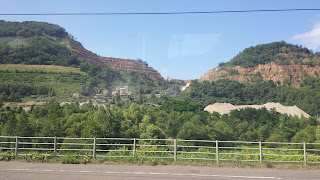If yesterday was about modern, American-inspired Japanese culture, this Saturday had me experiencing the Ainu culture and a Japanese festival at Susukino in Sapporo.
First, I got the chance to participate in the last day of the first ever conference in Japan about Indigenous people rights, held in Sapporo at Hokudai university, and it was arranged as a preconference to IGU2013 in Kyoto. I was actually going to attend both, but had to cancel it at the last moment. The themes of the talks before lunch held the red thread of that any efforts made by official society that is directed at or affects indigenous people must involve them in all parts of the process, otherwise the results are often the opposite, and that indigenous people often has knowledge that can improve on "modern" methods.
The "Maurimeter"(?) was an interesting way of measuring effects on the living conditions that integrated physical, mental and religious effects in a scientific form
From Taiwan, about dam building and its effects.
Professor Ono, the head organizer and a super nice man, about how the current Japanese "school book" version of the Ainu history needs retelling as it delimits their actual existence. As a culture they have both existed before the 12th century as part of the Jomon culture, and after the Meiji restoration of 1868, even if somewhat submerged in the Japanese state.
I sadly forgot his name, but this Ainu leader told us about how Hokkaido university has refused to release the remains from Ainu graves.
After the mini-conference, we went to the Ainu cultural museum by bus.
Professor Yuku ONO.
Free lunch and conference and bus ride and museum. Am I lucky or what. On the other hand it tells me that next time around I have to prepare even more as the hospitality on par of the Japanese can't be expected everywhere I go. ^_^
Both the Ainu and Japanese culture share a respect and caring for trees and forests. The animistic roots of both is something I really like and sometimes represent a kind of authentic environmental thinking we miss in Sweden. It's like we care for nature, but it's often kind of distant somehow, like nature is something distinct from ourselves or a victim.
Boat made 10 years ago. The ainu really didn't much use the expensive iron traded from the Japanese, instead it was ropes and moss (for sealing) that was used.
The Ainu houses consisted of one big main room which everyone shared (except newlyweds, they got their own for one full week...). The fire good was much respected as the central fire pit had to be carefully kept to avoid fires.
The eastern window was always slightly open, even during winters, as it is from where the gods watch over them.
Japanese Umbrella Stand with locks
Ainu music performance, started pretty as expected with them showing us the traditional instruments, which was good in itself.
And then, suddenly, a guitarist!
I actually didn't get the tougher rock'n'roll part with singing etc, but this clip shows the guitarist's skills.
And they rocked our socks off! Swedish: think Roger Pontare doing his folk/rock thingie. They told us about how music crosses borders, and that what they are doing at the center is creating modern Ainu culture which of course is the only way to go. Conservation in the end means death if nothing new is added.
Super pretty two year old girl and others in the end leading us along dancing around the room, clapping hands.
Maori conference members expressing their thanks with a traditional dance.
Mostly male dominated carriages, but this one was solely females
This was my favorite, this old man had such passion and stamina.
I am so sorry, but this yukata-dressed couple was my only photo of all the dressed up people in the streets, as I felt to shy to ask for a photograph of a yukata clad person, but I promise you they came in all sorts and sizes. I have seen people wearing them now and then, and so it obviously something for festive occasions beyond just big holidays.
















































Inga kommentarer:
Skicka en kommentar